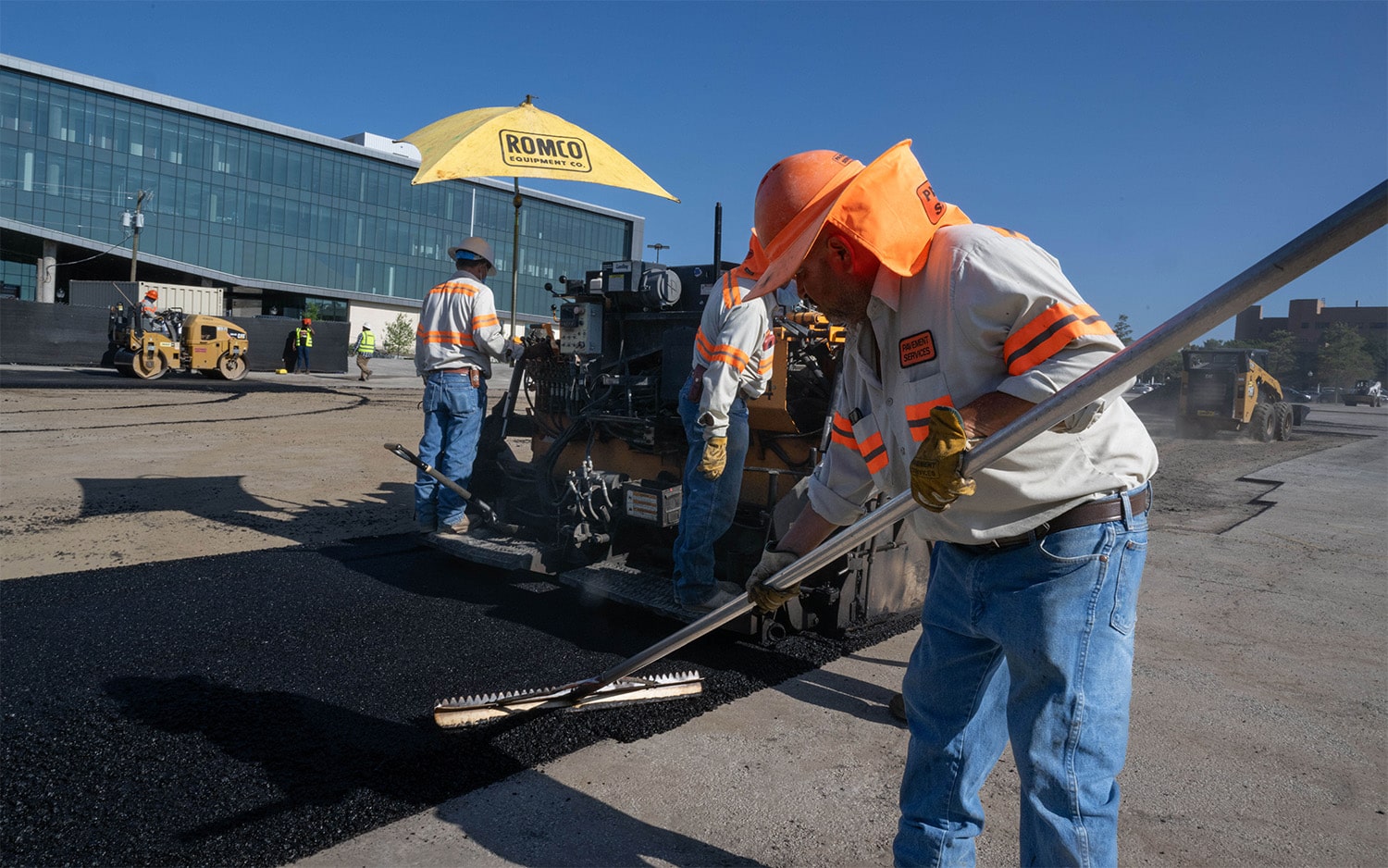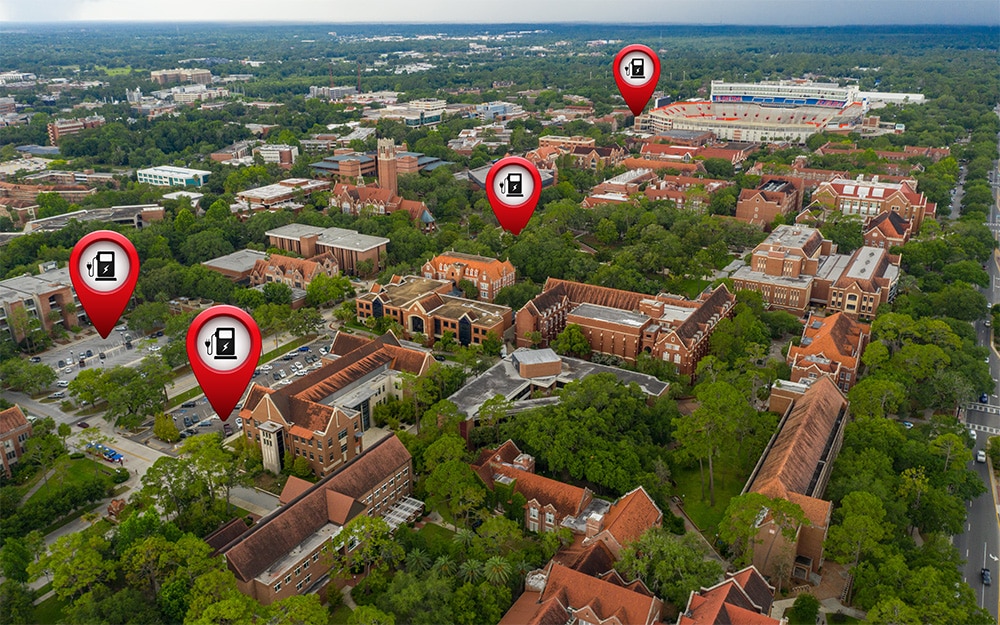
What innovation will have the most significant impact on parking and mobility in the next five years?
Innovations in AI, IoT, and 5G are set to revolutionize
Share:
Share:
About 50 miles northwest of the Denver International Airport sits the vibrant Town of Boulder, Colorado, a 27-square mile mountain community with 97,000 residents and a community-wide love of nature.
Boulder is home to companies big and small, from food innovation startups to tech and aerospace firms including Google and Lockheed Martin. And at the heart of it all is the award-winning University of Colorado (CU Boulder), the flagship of the University of Colorado System, where 29,000 undergrad and graduate students come annually to learn, innovate, and evolve into the change-makers of the future.
Boulder is famous for its environmental preservation, education, and quality of life. Nestled within this idyllic setting is truly a hotbed of change and innovation.
There is an innovative spirit deeply embedded in the fabric of CU Boulder and it has long been part of the school’s vision: The University of Colorado will be a premier, accessible, and transformative public university that provides a quality and affordable education with outstanding teaching, learning, research, service, and health care.
This vision permeates every aspect of their four campuses from the classrooms to the parking lots.
Long known for their engineering prowess, the university has been at the forefront of electric vehicle (EV) technology since the early 2000s. In 2011 the U.S. Department of Energy awarded the University of Colorado in Colorado Springs (UCCS) a five-year, $954,000 grant to develop master’s level course work dialing in on engineering careers and new technologies for vehicles using electric drivetrains.
In 2020, CU Boulder announced they would also have a major role in the new ASPIRE Center—Advancing Sustainability through Powered Infrastructure for Roadway Electrification focused on developing infrastructure and systems facilitating widespread adoption of EVs funded by a $26 million National Science Foundation (NSF) grant.
And these two examples are just the tip of the proverbial iceberg.
Much of University of Colorado’s interest in electrification is rooted in the real-world climate crises which surround their campuses. From drought induced wildfires to flooding, mudslides, and unpredictable weather patterns, climate change is regularly visible throughout Colorado.
It’s hard to forget the Marshall Fire that ripped through Boulder County, where nearly 1100 homes were lost in a matter of hours, just days after Christmas in 2021. Similarly, in 2013, Boulder was home to unprecedented flooding that took three lives, ushered in unimaginable mudslides and cost over $1 billion in property damage. So, when it comes to combating climate change, the university has a vested interest, well beyond building careers.
“The signs of the climate crisis are all around us, and the signs are undeniable,” Jonathan Koehn, Chief Sustainability and Resilience Officer for the City of Boulder and instructor in CU Boulder’s Masters of the Environment graduate program, shared at the inaugural Right Here, Right Now Global Climate Summit at CU Boulder this past October. “It is here, and it is now.”
In the fall of 2022, CU Boulder kicked off their comprehensive Climate Action Plan and laid out a path for mitigating climate change by fully examining all campus operations and procurement with the goal of reducing greenhouse gas emissions by 50% by 2030 and achieving total operational carbon neutrality no later than 2050.
“I am pleased we are in the process of developing the Climate Action Plan to move our university toward carbon neutrality, solidifying our efforts in the pursuit of climate action and justice,” said Chief Sustainability Officer Heidi VanGenderen. “It is essential for us to begin this process and lessen the effect of climate change on vulnerable communities. We must use the resources available as a leading institution in climate solutions, encouraging leadership within students, staff, and faculty to pursue climate action and fostering resilience in the process.”
All four of the University of Colorado campuses—Boulder, Aurora, Colorado Springs, and Denver—are united in championing their sustainability efforts which include energy consumption, sustainability planning, facility design and LEED certification, water conversation and diversion, and of course, transportation.
CU Boulder, whose passion for the environment can be traced back to 1970 when the nation’s first student-led environmental center was established, has long promoted the use of alternative modes of transportation and the use of new fuel vehicles to reduce greenhouse gas emissions from travel to and through its campuses.

Bike lanes, walking paths, campus buses, and ride sharing have long been strategically important initiatives and part of the fabric of the CU culture. A great example of this in action is the fleet of more than 100 BCycle eBikes—all free (with a university-issued permit) for full-time students, faculty, and staff members. Additionally, 17 eBikes were distributed to frontline service employees through the Can Do Colorado eBike program.
This robust eBike sharing program is further supported with more than 15 B-cycle stations located campus wide, endless miles of procured campus and town bike routes, and student staffed bike stations which offer services like safety checks, inflating tires, lubricating chains, adjusting brakes, and fixing flats year round.
These resources are so popular, the University boasts that on any given September day, more than 50% of CU commuters employ energy efficient “micromobility transportation” including walking, riding on a bike, skateboard or scooter to travel between home and campus.
It was only natural for the University to carry this spirit forward into their “macromobility” or internal combustion engine motorized transportation.
Beginning in 2011, a 100-kW carport was installed at CU Boulder’s Bear Creek Apartment Complex, shading numerous vehicles from the 300 days of Colorado sunshine and generating enough power to fuel the equivalent of 20 single-family homes for a year.
This project was shortly followed by introducing the state’s first public EV charging station, and the University’s transportation strategy has only grown and “greened” from there.
Over the past ten years, CU Boulder has added and integrated 56 Level-2 charging plugs across the campus. The EV program was accelerated partially from grants through Charge Ahead Colorado, a program designed to incentivize widespread charging infrastructure throughout Colorado and that has made awards for more than 2,000 EV charging stations across the state.
All the CU chargers are open to any plug-in EV user and run via the ChargePoint network. Unlike the B-cycle program, the chargers are not free, but rather function as a parking payment machine that assesses a small $1.50 hourly charging fee plus a variable short term parking fee for visitors or staff without a CU permit.
With the average EV gaining 20-25 miles of driving range from an hour of Level-2 charging, the hourly ‘fueling’ fee is a relative bargain when compared to current gas prices, and the University can cover the costs of the energy dispensed.
In addition to bringing electric fueling to their parking lots, the University’s Transportation Services team launched an aggressive electrification initiative from light to heavy duty vehicles just prior to the pandemic. Ten of more than 50 of the University’s Level-2 charging plugs are reserved specifically for this burgeoning campus fleet, which is gradually shifting from fossil fuels to electricity.
For example, the Distribution Center, which manages deliveries across CU Boulder campuses, is now using a fully electric Ford eTransit as well as a Chevy Bolt for daily trips to CU properties in Denver.
There is also an aggressive plan in place to electrify the campus wide busing system. The first two eBuses came on line this past fall. These buses replaced existing diesel counterparts that were more than 28 years old and had driven over 700K miles around campus. As Assistant Director of Transportation Services Tom Christian says, “they’re ready to pass the torch.”
The new buses, which were partially funded by a U.S. Environmental Protection Agency Diesel Emissions Reduction Act (DERA) grant, look exactly the same except for a lightning bolt icon, and feature safety sounds for turns and backing up, since there is no engine noise.
These buses are integral to reducing CU Boulder’s carbon footprint. “The positive environmental impact of the buses will be immense,” shared Ed von Bleichert, the University’s Sustainability and Resilience Program Manager. “By taking two diesel vehicles off the road, we are reducing the end-of-pipe emissions by roughly 150 tons of carbon dioxide, and we will save more than 13,000 gallons of diesel. Electric vehicles have their own emissions, to be sure, but we will only see more benefits as the technology improves.”
Among the many sustainable initiatives in the works in planning for 2023 is an electric car sharing (or eCar Share) program that will be integrated as part of one of the University’s newest buildings, Williams Village North, which is also billed as one of the greenest buildings on campus.
As the nation’s largest LEED Platinum residence hall, Williams Village North uses 39% less energy than traditional buildings of its size. It was also constructed using many recycled and locally sourced materials and uses ditch water for landscape irrigation, among its dozens of other environmentally responsible attributes.
The hall is just one of the 30 LEED-certified buildings on campus and as you might suspect, many of these LEED buildings host EV charging infrastructure.
As the Williams Village North project demonstrates, the sustainability lens creates focus for much of the University of Colorado’s decision making and action. Mitigating climate change is truly integrated into every aspect of student campus life—because it needs to be.
In the words of University Chancellor Phil DisStefano, “The imperative to address climate change has never been greater. In discussing this issue with student leaders, we agree that the scientific evidence of climate change overwhelmingly demands action now to address the climate emergency. This means redoubling our resolve to unleash the immense human capacity for innovation and applied solutions at sufficient speed and scale.”
While there is always an opportunity to do more, the University of Colorado has built an infrastructure foundation to meet today’s needs while crafting a flexible vision for future transportation electrification—all in service of meeting their goal of reducing greenhouse gas emissions by 50% by 2030—just eight short years away. ◆
RJ Harrington is SVP of Business Development at National Car Charging.

Innovations in AI, IoT, and 5G are set to revolutionize

A New Frontier in Sustainability

Charting the Electrification Journey for Academic Campuses.
Parking & Mobility is IPMI’s flagship publication, covering the news, trends, analysis, technologies, and people of the parking and mobility industry, and how it affects and influences communities around the world.
| Cookie | Duration | Description |
|---|---|---|
| cookielawinfo-checkbox-advertisement | 1 year | Set by the GDPR Cookie Consent plugin, this cookie is used to record the user consent for the cookies in the "Advertisement" category . |
| cookielawinfo-checkbox-analytics | 11 months | This cookie is set by GDPR Cookie Consent plugin. The cookie is used to store the user consent for the cookies in the category "Analytics". |
| cookielawinfo-checkbox-functional | 11 months | The cookie is set by GDPR cookie consent to record the user consent for the cookies in the category "Functional". |
| cookielawinfo-checkbox-necessary | 11 months | This cookie is set by GDPR Cookie Consent plugin. The cookies is used to store the user consent for the cookies in the category "Necessary". |
| cookielawinfo-checkbox-others | 11 months | This cookie is set by GDPR Cookie Consent plugin. The cookie is used to store the user consent for the cookies in the category "Other. |
| cookielawinfo-checkbox-performance | 11 months | This cookie is set by GDPR Cookie Consent plugin. The cookie is used to store the user consent for the cookies in the category "Performance". |
| CookieLawInfoConsent | 1 year | Records the default button state of the corresponding category & the status of CCPA. It works only in coordination with the primary cookie. |
| elementor | never | This cookie is used by the website's WordPress theme. It allows the website owner to implement or change the website's content in real-time. |
| viewed_cookie_policy | 11 months | The cookie is set by the GDPR Cookie Consent plugin and is used to store whether or not user has consented to the use of cookies. It does not store any personal data. |
| Cookie | Duration | Description |
|---|---|---|
| _ga | 2 years | The _ga cookie, installed by Google Analytics, calculates visitor, session and campaign data and also keeps track of site usage for the site's analytics report. The cookie stores information anonymously and assigns a randomly generated number to recognize unique visitors. |
| _ga_02PMHW8YWC | 2 years | This cookie is installed by Google Analytics. |
| _ga_LC0QJJHM3J | 2 years | This cookie is installed by Google Analytics. |
| _ga_V9KYTSBYT2 | 2 years | This cookie is installed by Google Analytics. |
| iutk | 5 months 27 days | This cookie is used by Issuu analytic system to gather information regarding visitor activity on Issuu products. |
| Cookie | Duration | Description |
|---|---|---|
| mc | 1 year 1 month | Quantserve sets the mc cookie to anonymously track user behaviour on the website. |
| Cookie | Duration | Description |
|---|---|---|
| ultp_view_1052 | 1 day | No description |
| ultp_view_1058 | 1 day | No description |
| ultp_view_1060 | 1 day | No description |
| ultp_view_1064 | 1 day | No description |
| ultp_view_1068 | 1 day | No description |
| ultp_view_1070 | 1 day | No description |
| ultp_view_1072 | 1 day | No description |
| ultp_view_1078 | 1 day | No description |
| ultp_view_1082 | 1 day | No description |
| ultp_view_1088 | 1 day | No description |
| ultp_view_1100 | 1 day | No description |
| ultp_view_1103 | 1 day | No description |
| ultp_view_1114 | 1 day | No description |
| ultp_view_1118 | 1 day | No description |
| ultp_view_1122 | 1 day | No description |
| ultp_view_1125 | 1 day | No description |
| ultp_view_1130 | 1 day | No description |
| ultp_view_1132 | 1 day | No description |
| ultp_view_1135 | 1 day | No description |
| ultp_view_1541 | 1 day | No description |
| ultp_view_1554 | 1 day | No description |
| ultp_view_1557 | 1 day | No description |
| ultp_view_1560 | 1 day | No description |
| ultp_view_1563 | 1 day | No description |
| ultp_view_1568 | 1 day | No description |
| ultp_view_1572 | 1 day | No description |
| ultp_view_1576 | 1 day | No description |
| ultp_view_1580 | 1 day | No description |
| ultp_view_2305 | 1 day | No description |
| ultp_view_2321 | 1 day | No description |
| ultp_view_2338 | 1 day | No description |
| ultp_view_2342 | 1 day | No description |
| ultp_view_259 | 1 day | No description |
| ultp_view_270 | 1 day | No description |
| ultp_view_275 | 1 day | No description |
| ultp_view_286 | 1 day | No description |
| ultp_view_3074 | 1 day | No description |
| ultp_view_3115 | 1 day | No description |
| ultp_view_3334 | 1 day | No description |
| ultp_view_3336 | 1 day | No description |
| ultp_view_3338 | 1 day | No description |
| ultp_view_3340 | 1 day | No description |
| ultp_view_3346 | 1 day | No description |
| ultp_view_3354 | 1 day | No description |
| ultp_view_3361 | 1 day | No description |
| ultp_view_3367 | 1 day | No description |
| ultp_view_365 | 1 day | No description |
| ultp_view_367 | 1 day | No description |
| ultp_view_38 | 1 day | No description |
| ultp_view_3846 | 1 day | No description |